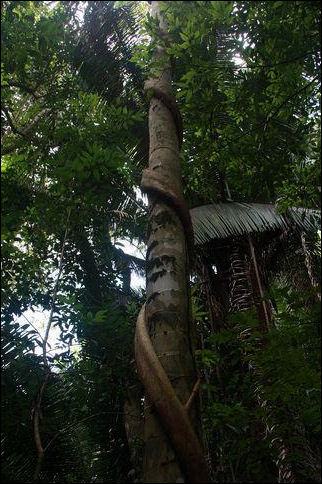TROPICAL RAINFORESTS
liana in Belize A tropical rainforest is defined as a forest in a tropical region, generally between the Tropics and Cancer and Capricorn, with a large amount of rainfall. By contrast, there are tropical dry forests and temperate rainforests. Tropical rainforests are known for being rich in both plant and animal life, a condition expressed by the term biodiversity.
There is about 1.2 billion hectares of tropical forest in the world. Tropical rainforests cover half the worlds woodlands, 14 percent of the world’s land surface and 6 percent of the Earth’s total surface area. Some rainforests have remained virtually unchanged for millions of years. In the same period lakes have appeared and dried up, volcanoes have produced new mountains worn down by erosion and grasslands have become deserts.
The first tropical rainforests began to form roughly 140 million years ago, during the age of the dinosaurs, when the climate of nearly the entire world was tropical. Flowering plants also evolved during this period, and with them their symbiotic relationship with wasps, beetles, bees, flies, butterflies, and moths who pollinated the flowers.▸
Scientists define five different tropical habitats: 1) primary forests with trees 115 to 180 feet high; 2) secondary forests with trees 50 to 60 feet high; 3) Cecropia, mainly with palms up to 50 feet high; 4) scrub and shrubs up to 6.5 feet high; 5) pasture up to 1.5 feet.
There are a number of different kinds of rainforests: montane rainforests in the mountains, lowland rainforests in lowlands, riverine rainforests along rivers, esturine rainforests near estuaries and cloud forests where clouds collide with the slopes of tropical mountains. The word jungle is often times misused as a synonym for rainforest. A jungle refers to dense growth adjacent to an open area.
Based on discoveries made of a 300-million-year-old fossilized forest found in a coal seem in Illinois, club mosses grew over a meter thick and 40 meters high in primordial rainforests.
See Separate Articles: AMAZON: THE RIVER AND FOREST AND THEIR HISTORY AND ECOLOGY factsanddetails.com; RAINFOREST TREES, FRUITS, PLANTS AND BAMBOO factsanddetails.com; RAINFOREST LIANAS, FIGS, EPIPHYTES, FERNS, BROMELAIDS AND FUNGI factsanddetails.com; STUDYING THE RAINFOREST: METHODS, TECHNOLOGIES AND HARD WORK factsanddetails.com
Websites and Resources: Rainforest Action Network ran.org ; Rainforest Foundation rainforestfoundation.org ; World Rainforest Movement wrm.org.uy ; Wikipedia article Wikipedia ; Forest Peoples Programme forestpeoples.org ; Rainforest Alliance rainforest-alliance.org ; Nature Conservancy nature.org/rainforests ; National Geographic environment.nationalgeographic.com/environment/habitats/rainforest-profile ; Rainforest Photos rain-tree.com ; Rainforest Animals: Rainforest Animals rainforestanimals.net ; Mongabay.com mongabay.com ; Plants plants.usda.gov ;Books: “The Private Life of Plants: A Natural History of Plant Behavior” by David Attenborough (Princeton University Press, 1997); “Portraits of the Rainforest” by Adrian Forsythe. National Geographic articles “Rainforest Canopy, the High Frontier” by Edward O. Wilson, December 1991 ▸; “Tropical Rainforests: Nature's Dwindling Treasures”, by Peter T. White, January 1983 ∩
Tropical Rainforest Components and Complexity
A group of professors wrote in The Conversation: Tropical forests are more than just trees — they are complex, dynamic networks of plants, animals and microbes. Active research areas typically emphasize how specific features of forests, such as the number of species they contain or tree biomass, change over time and space. [Source: Robin Chazdon, Professor Emerita of Ecology and Evolutionary Biology, University of Connecticut, Catarina Conte Jakovac, Associate professor of Plant Science, Universidade Federal de Santa Catarina, Lourens Poorter, Professor of Functional Ecology, Wageningen University, The Conversation, and Bruno Hérault, Tropical Forest Scientist, Forests & Societies Research Unit, Cirad, The Conversation December 10, 2021]
Important components a key areas of study within them include: 1) Soil: How much organic carbon and nitrogen does it contain, and how compacted is it? Soil that is too densely compacted — for example, by the hooves of grazing cattle — is hard for plant roots to penetrate and doesn’t absorb water well, which can lead to erosion. 2) Ecosystem functioning: How does the abundance and size of trees change as the forest regrows? What is the role in forest regrowth of trees that have root associations with nitrogen-fixing bacteria? How does regrowth affect the average density of wood and the durability of leaf tissues?
3) Forest structure: How do maximum tree size, variation in tree size, and total biomass — the quantity of plant matter above ground in tree trunks, branches and leaves — change as forests regrow? 5) Diversity and composition of tree species: How do the numbers of tree species present and the diversity and abundance patterns of species change and become more similar to nearby old-growth forests?
Rainforest Canopy
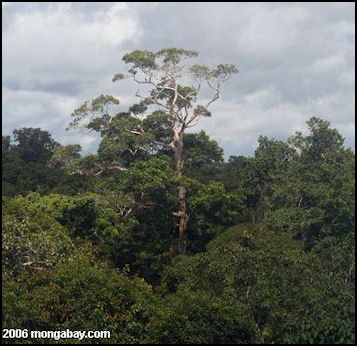
above canopy The upper branches of the rainforest trees and the vegetation found in them are referred to as the canopy. It extends for about five to seven meters (16 to 23 feet) deep from the tops of the trees. The vastness and complexity of system is one reason why the rainforest contains over half of all the world's species.
The trees that make up the canopy vary in height between 30 and 45 meters (100 and 150 feet), with a few towering 60 meters (200 feet) or more. The trees have trunks free of branches for the first sixty feet or so and nearly horizontal upper branches. Scientists have estimated that the total surface of the leaves and branches on the world's forest canopies is equal to the total surface of the earth.
Virgin rainforests are made up of a nearly continuous canopy of trees with flattened crowns. Describing what it is like be up there, David Attenborough wrote: "Suddenly the humid twilight is replaced by fresh air and sunshine. Around you stretches a limitless meadow of leaves...dimpled like the surface of enormously enlarged cauliflower. Here and there, standing 10 meters or more over the rest, rises a single giant tree...Up here the wind blows freely through their crowns...the air is warm and humid."
Life and Soil in the Rainforest Canopy
The canopy captures 90 percent of sunlight, conducts the bulk of the photosynthesis activity and is home to nearly all the animals, plants, insects and birds. Many creatures live their entire lives and die in the canopy without every setting foot on the ground. While many species in the canopy are very similar to each other, they often have very little in common with species found near the ground.
Once a tree has grown tall enough to become part of the canopy it serves as a host for palm trees, parasitic vines like figs and flowering plants. Many forms of life rely on “soil” found on tree branches rather than on the ground soil.
On the 100-foot-high branches of some large trees there is foot-thick soil with earthworms. This soil made up of wind-borne dust, fallen leaves, decomposed fungi and moss, other detritus (decayed organic material), animal droppings and plant and animal remains. The mixture is like a bog, and especially thick where the branches come together.
Living on top of this soil are leafy plants such as orchids, philodendrons, ferns, bromeliads, and flora related to azaleas, violets and pepper plants. Growing on the leaves and the undersides of the branches are lichens and mosses. And living among all this are birds, insects, small mammals, worms, caterpillars, spiders, butterflies, hummingbirds, lizards and salamanders.▸
Mid-Level and Low-Level Rainforest Life
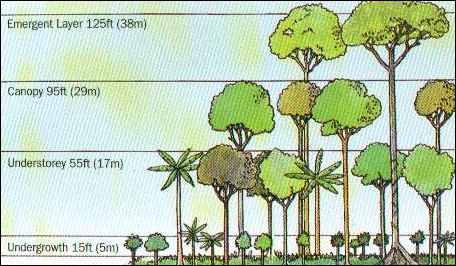
Rainforest strata The area below the canopy is sometimes called the understory. Very little light penetrates the canopy and the species of trees below it include adolescent canopy trees working their way up and mature tree species that thrive in the twilight region.
Lower down are at the height of human beings is a lower canopy of saplings and herbaceous plants. The layer of leaves, not as dense as the canopy but still significant. These are produced by the small trees and palms and other plants adept at living in dim light. The lower canopy is kind of like a way station for animals on their way between the canopy and the ground.
There isn't much visible activity going on in the rainforest at ground level, which sometimes receive only one percent of the sunlight that reaches the canopy. The canopy is so thick that people who work in the rainforest almost never see the sky and rain from a cloudburst take ten minutes before it reaches the ground.
But that doesn’t mean there isn’t stuff going on. David Attenborough wrote: "It is very hot and stagnant and loaded with moisture. Such conditions suit the process of decay. bacteria and mold work unceasingly. Fungi proliferate, spreading their filaments through the leaf litter and erecting their bodies. The speed of decomposition is extraordinarily rapid."
The canopy trees block all but one percent of the sunlight. Despite rainfall of up to 16 feet a year saplings on the floor of primary forests only grow around an third of an inch a year. At that rate it would take 3,000 years to reach the canopy.
Rainforest Soils
Tropical rainforest soil is very thin and low in nutrients. With no winters or frosts to kill insects or microorganisms, and with lots of heat and humidity to help them grow and multiply, organic matter such as fallen leaves and twigs decomposes so quickly that only a thin layer of organic material covers the soils.
The soils are heavily leached of nutrients by rain water. But in many cases that doesn't matter much because the nutrients are absorbed by other life forms before the rain has a chance to carry them away. Trees absorb the nutrients with thick mats of rootlets that grow close to the surface of the soil.
Rainforest soils are generally terrible for agriculture, producing crops for one to three years before being depleted of nutrients (See Slash and Burn Agriculture). How is it then that a tropical rainforest is so rich in life. The secret is a quick turnover of nutrients.
When leaves, trees, plants of animals die they fall to the forest floor where they are quickly recycled into mulch by insects and fungi. Bacteria then plays a crucial part converting the mulch and litter into nutrients consumed by plants. The air at ground level in a tropical rainforest, according to Harvard biologist and ant specialist Edmond Wilson is "humid and saturated with odors of healthy decay."▸
Only two organisms can break down dead plants into usable nutrients: bacteria and fungi. In wet, humid, dark and hot conditions in the rainforest fungi and bacteria can break down cellulose very quickly. Since there is little wind in the forests. leaves tend to fall straight down. Thus, many plants fed on nutrient they themselves deposited. Termites also play a major roll converting cellulose to nutrients that can be consumed by other animals. The termites themselves a favorite food of many animals.
See Deforestation

Borneo
Rainforest Weather
Compared to the changing weather conditions in temperate forest, the condition in tropical rainforests remains pretty much the same: being close the equator the amount of sunlight and warmth are almost the same everyday. The main variations are the rainfall amounts which often time change between the wet and dry season.
Rainforests receive anywhere from 80 inches to extremes of 400 inches of rain a year. Generally, a third of the rain evaporates, a third is absorbed by roots and greenery and third runs off. Even during strong thunderstorms sometimes little rain penetrates the canopy and reaches the ground. Instead it is absorbed by plants and collects in pools in the leaves and branches in the upper reaches of the rainforest.
The heat in the tropics is strong enough to melt the paint on the walls of steel hulled ships. The shade provided by all the trees in the rainforest, however, keeps the temperatures lower than they otherwise would be. The humidity though makes being in the forest very uncomfortable for many people.
The temperature and humidity are relatively constant at ground level in the tropical rainforest, but varies in the upper branches of the trees. Sunlight bakes the vegetation there, occasionally raising the temperature of the surrounding air to a full 10̊ higher than the ground level temperatures The relative humidity in the upper levels of the rainforest can range from as high as 100 percent at night to less than 30 percent at midday. ▸
Fluctuating temperatures and humidity, intense sunlight, torrential rains and winds can create "unpredictable microclimates" and eddies of wind that move trees and pump air and nutrients into canopy in an "accordion-like" fashion. [Source: Carol Kaesuk Yoon, New York Times, November 22, 1994; "Forest Canopies" Dr. Nadkarni, Academic Press]
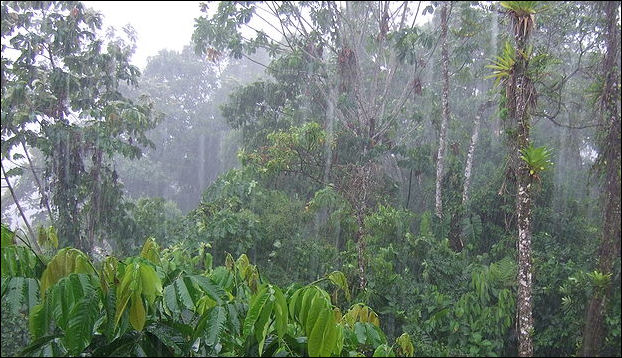
rain in the rain forest
Meteor That Killed Dinosaurs Also Created Modern Tropical Forests
The cataclysmic asteroid strike 66 million years ago off the Yucatán Peninsula that killed off the dinosaurs — the Chicxulub impact event — also changed tropical forests in distinct ways as evidenced by fossils. "This single historical accident changed the ecological and evolutionary trajectory of the rainforest forever," said Carlos Jaramillo, a paleontologist at the Smithsonian Tropical Research Institute in Panama and co-author of the study published in Science. "Without the meteorite, living in the tropical forest today would be very different." [Source: Alison Snyder, Axios, April 2, 2021]
Axios reported: “Over 12 years, Jaramillo and his colleagues collected and analyzed more than 6,000 specimens of fossilized leaves and 50,000 fossilized pollen samples in Colombia spanning the Late Cretaceous and early Paleogene period. The researchers measured changes in the density of leaf veins, the diversity of insect damage and other attributes to quantify how the forest plants' diversity and structure changed from the impact. Before the Chicxulub impact event, the forests were a mix of flowering plants, ferns and conifers with an open canopy that allowed light to pour into the forest. After the impact, 45% of the plant species went extinct (pollen fossils for the species vanished in the record) and flowering plants came to dominate a more closed canopy, forming the forests seen today.
Why did the forests change rather than return to their pre-impact state, especially since the climate was similar in both periods? Jaramillo offers three possibilities: 1) The disappearance of dinosaurs, which flattened the forest floor and fed on the canopy, reduced competition for light between plants and allowed flowering flora to take off. 2) Ash from the impact brought phosphorus to the ground, creating a rich niche for fast-growing, nitrogen-fixing flowering plants to take off. Jaramillo says the team plans to collect samples of soil preserved in rocks to measure their nutrient content. 3) The conifers that evolved to be canopy trees in the tropics went extinct, whereas flowering plants were diversifying and "doing all sorts of things," he says.
It took 6 million to 7 million years for the diversity of plants in the forest to return to levels before the collision. “"The lesson that comes out of these studies looking at rebuilding is that diversity doesn't come back right away," says Sean Gulick, who studies the Chicxulub impact and its effect on marine ecology at the University of Texas Institute for Geophysics and wasn't involved in the new research.
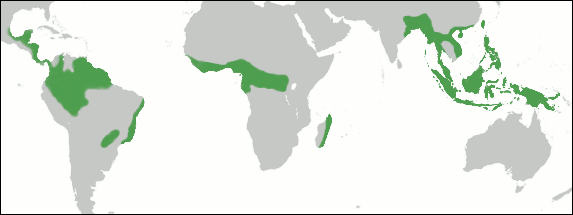
location of tropical rain forests
Image Source: Mongabay mongabay.com ; Wikimedia Commons
Text Sources: “The Private Life of Plants: A Natural History of Plant Behavior” by David Attenborough (Princeton University Press, 1997); National Geographic articles. Also the New York Times, Washington Post, Los Angeles Times, Smithsonian magazine, Natural History magazine, Discover magazine, Times of London, The New Yorker, Time, Newsweek, Reuters, AP, AFP, Lonely Planet Guides, Compton’s Encyclopedia and various books and other publications.
Last updated April 2022

